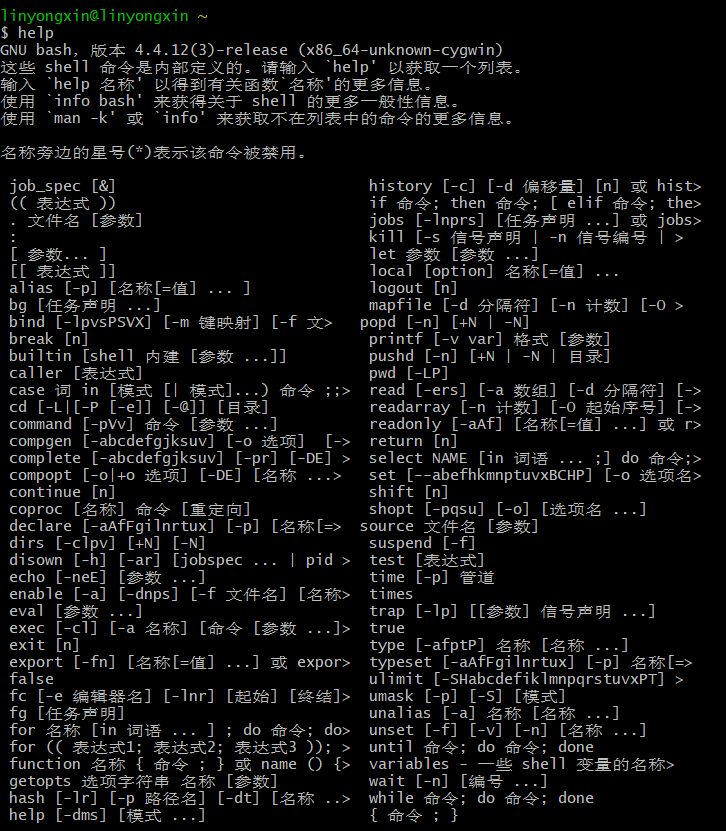- 姓名:林永鑫
- 学号:201821121040
- 班级:计算1812
1. 实验环境介绍
给出实验环境:
- 操作系统:Windows10家庭中文版

- 平台:Cygwin

2. 常用命令使用
部分命令
man

help

logout:登出
exit:注销
3. 剖析ps命令
运行man ps:
SYNOPSIS
ps [−aA] [−defl] [−g grouplist] [−G grouplist]
[−n namelist] [−o format]... [−p proclist] [−t termlist]
[−u userlist] [−U userlist]
DESCRIPTION
The ps utility shall write information about processes, subject to
having appropriate privileges to obtain information about those pro‐
cesses.
By default, ps shall select all processes with the same effective user
ID as the current user and the same controlling terminal as the in‐
voker.
OPTIONS
The ps utility shall conform to the Base Definitions volume of
POSIX.1‐2008, Section 12.2, Utility Syntax Guidelines.
The following options shall be supported:
−a Write information for all processes associated with termi‐
nals. Implementations may omit session leaders from this
list.
−A Write information for all processes.
−d Write information for all processes, except session leaders.
−e Write information for all processes. (Equivalent to −A.)
−f Generate a full listing. (See the STDOUT section for the
contents of a full listing.)
−g grouplist
Write information for processes whose session leaders are
given in grouplist. The application shall ensure that the
grouplist is a single argument in the form of a <blank> or
<comma>-separated list.
−G grouplist
Write information for processes whose real group ID numbers
are given in grouplist. The application shall ensure that
the grouplist is a single argument in the form of a <blank>
or <comma>-separated list.
−l Generate a long listing. (See STDOUT for the contents of a
long listing.)
−n namelist
Specify the name of an alternative system namelist file in
place of the default. The name of the default file and the
format of a namelist file are unspecified.
−o format Write information according to the format specification given
in format. This is fully described in the STDOUT section.
Multiple −o options can be specified; the format specifica‐
tion shall be interpreted as the <space>-separated concate‐
nation of all the format option-arguments.
−p proclist
Write information for processes whose process ID numbers are
given in proclist. The application shall ensure that the
proclist is a single argument in the form of a <blank> or
<comma>-separated list.
−t termlist
Write information for processes associated with terminals
given in termlist. The application shall ensure that the
termlist is a single argument in the form of a <blank> or
<comma>-separated list. Terminal identifiers shall be given
in an implementation-defined format. On XSI-conformant sys‐
tems, they shall be given in one of two forms: the device's
filename (for example, tty04) or, if the device's filename
starts with tty, just the identifier following the characters
tty (for example, "04").
−u userlist
Write information for processes whose user ID numbers or lo‐
gin names are given in userlist. The application shall en‐
sure that the userlist is a single argument in the form of a
<blank> or <comma>-separated list. In the listing, the nu‐
merical user ID shall be written unless the −f option is
used, in which case the login name shall be written.
−U userlist
Write information for processes whose real user ID numbers or
login names are given in userlist. The application shall
ensure that the userlist is a single argument in the form of
a <blank> or <comma>-separated list.
运行命令ps -ef系统的返回结果:

运行命令ps -aux系统返回的结果:

解释命令中参数的含义
-e:显示出所有进程
-f:完整的格式
解释返回结果每个字段的含义
UID:程序被该UID所拥有
PID :这个程序的 ID
PPID:其上级父程序的ID
C:CPU使用的资源百分比
STIME:系统启动时间
TTY:终端机位置
TIME:执行的时间
COMMAND:执行的指令
a:显示现行终端机下的所有程序,包括其他用户的程序
u:以用户为主的格式来显示程序状况
x:显示所有程序,不以终端机来区分
PGID:进程组ID
4. 通过该实验产生新的疑问及解答
1.问题:如何修改cygwin用户名为自己的名字:
解决方法:在cygwin里面运行mkpasswd -l > /etc/passwd生成passwd文件
然后在cygwin的etc目录中找到passwd文件
修改passwd文件中用户名的部分,我的是把ASUS改为linyongxin
在cygwin/home目录中把原本的用户名文件夹删除,并且新建一个自己名字(linyongxin)的文件夹
2.问题:刚安装完cygwin时运行man ps出现如图所示的情况

原因分析:查询了百度后知道可能是man手册不全,缺少关于ps的手册
解决方法:重新下载一个man包并用它替换安装后默认的man包